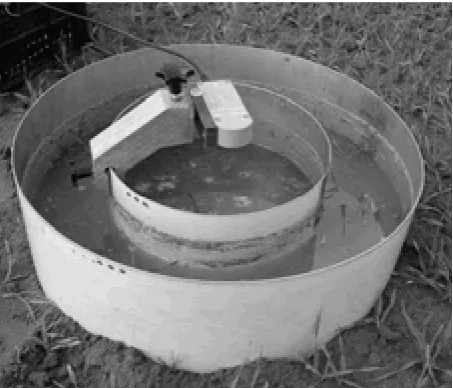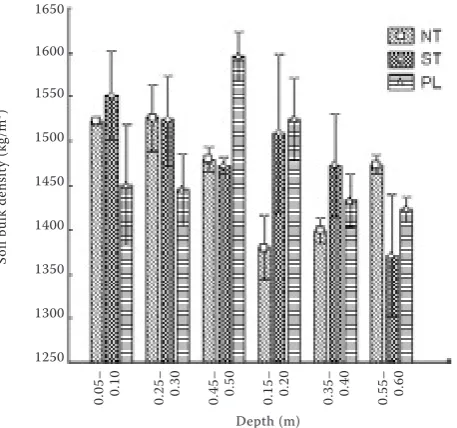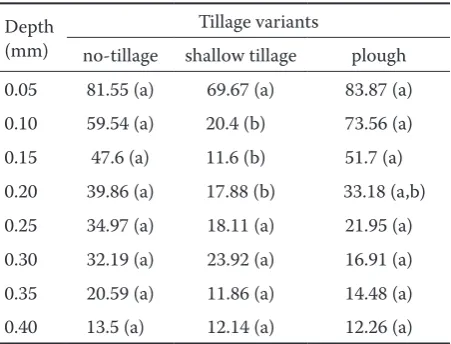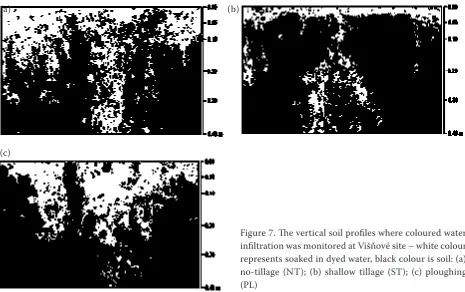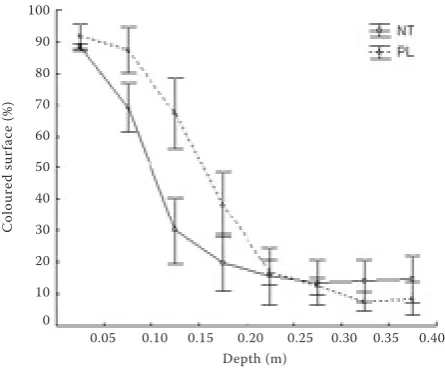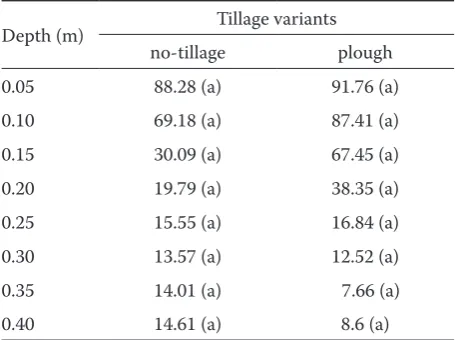The development of the technologies for the soil cultivation has a long history, at present the interest is justly focused on ecological and technological aspects (TITI 2002). The reduction of the surface
water runoff is one of the basic objectives of the landscape farming because it represents a signifi-cant factor influencing the rainfall balance of sites and the risk of water soil erosion (JANEČEK et al.
Water Infiltration into Soil Related
to the Soil Tillage Intensity
MILAN KROULÍK
1, JOSEF HŮLA
1,2, RUDOLF ŠINDELÁŘ
1and FRANTIŠEK ILLEK
31
Faculty of Technology, Czech University of Life Sciences in Prague, Czech Republic;
2Research Institute of Agricultural Engineering, Prague, Czech Republic;
3
Agroservis, 1
stAgricultural, a.s., Višňové, Czech Republic
Abstract: Soil infiltration capacity is one of the key factors in the soil protection against unfavourable effects of water erosion. The purpose of its measuring was to compare and evaluate the changes of the soil physical properties and of water infiltration into soil caused by different intensity of soil cultivation at two individual sites. The ploughing (PL), shallow tillage (ST), and direct drilling (NT) effects on the soil physical properties, water infiltration into soil, and soil surface coverage with the crop residua under the soil condition loamy Haplic Luvisol, with long-term growing of maize (Zea mays L.) – Agroservis, 1st Agricultural, a.s., Višňové – and clay soil of Calcic Chernozem (Cooperative farm Klapý), were compared. Soil bulk density values in the variant with ploughing showed in the depth up to 0.20 m considerably lower values as compared with the variants shallow tillage and direct drilling. Nevertheless, in the subsoil layer the bulk density of soil in the variant with plough-ing increased in comparison with other variants. The results were also confirmed by the cone index values. At the plots in Višňové the infiltration was evaluated utilising the double ring infiltrometer, and by means of the coloured water infiltration. The results revealed significant differences in the water infiltration rate at vari-ous stages of the soil loosening. The highest average values were recorded for ploughing (1.00 dm3/min). The lowest values were found for the shallow soil tillage (0.18 dm3/min). The variant with direct drilling showed values of 0.53 dm3/min. The coloured water infiltration evaluation showed a different character of water flow in soil. The variant with ploughing showed water saturation in the top layer, the variants with reduced tillage were characterised by vertical macropores and crack effects with the water drain into deeper layers. Ploughing proved its advantage for the short-term rainfall retention. Similar results were also brought in the evaluation on the plot with clay soil (Klapý). The loosening effect was evident during coloured water infiltration in the period of snow thawing. The loosed soil layer showed a significantly higher soil water holding capacity as compared with variants with reduced soil tillage. The result showed major differences in the water infiltration rate into soil and different characters of water infiltration into soil at different soil tillage.
Keywords: water infiltration; water erosion; soil tillage
2002). In view of agriculture, environmental pro-tection, and water management, the speed of water motion in soil is of fundamental importance. Soil erosion is the main global problem of today hav-ing a high economical and environmental impact (LAL 1995; PIMENTEL et al. 1995). Human-induced soil erosion is a problem because it occurs more rapidly than the process of the soil formation. Soil water erosion is a significant problem mainly in the regions with higher rainfalls and plot slopes. A direct connection exists between soil erosion and intensive agricultural production (REICOSKY
et al. 2005).
DEXTER (1988) defines the soil environment as a spatial heterogeneity of various components and soil properties. The soil cultivation is considered as a mechanical impact in soil for the purpose of generation of conditions for crops growth and development (OR & GHEZZEHEI 2002). The impact effect varies according to the impact intensity and place. Direct soil processing decomposes the soil aggregates and compactness, and changes the pore size, distribution, and structure (TITI 2002). After cultivation, the soil is in an instable state as porosity and other physical soil proper-ties are changing with time (LEIJ et al. 2002). Water absorption into soil is important for the soil protection against excessive surface water runoff (MORGAN 2005).
The soil protection against water erosion has been observed up-to-date mainly in the period of intensive rainfalls during springs and summers. Also important is the problem of the surface water runoff and erosion in the periods of snow thawing on the frozen soil or the rainfalls onto frozen soil. The risk in this period is high mainly on long slopes, if soil surface is free of crop cover or its remainders, the soil surface is not frozen but water infiltration into soil is low due to the frozen water in the soil pores under the soft layer (SCHILLINGER 2001).
MATERIAL AND METHODS
The assessment of water infiltration into soil was conducted on two plots with different soil properties, experiments were established with three variants of soil tillage and seeding. Water infiltration speed into soil and the consequent visualisation of water motion within the soil profile was measured in September 2005 on the plot in the maize (Zea mays) production region where a
pilot stationary field experiment was established in 2001 (Agroservis; 1st Agricultural, plc; Višňové).
Soil conditions: loamy Haplic Luvisol. The experi-mental variants of different tillage intensity and depth for grain maize, since 2002 grown repeat-edly as permanent crop:
– conventional tillage with ploughing (PL) to the depth of 0.20 m, spring harrowing, cultivation with tiller Horsch Phantom before seeding, seed-ing (Kinze 3600), rollseed-ing
– shallow tillage (ST) with a disc tiller to the depth of 0.10–0.12 m, cultivation with tiller Horsch Phantom before seeding, seeding (Kinze 3600), rolling
– no-tillage (NT), seeding (Kinze 3600).
The erosive action significantly influences the infiltration property of soil. A double ring infil-trometer Eijkelkamp was used for determining water infiltration. The water layer fall was measured with a telemetric ultrasonic sensor (Figure 1). The output signal from the sensor was recorded by the measuring unit. The recording time interval of 10 s was chosen.
For the water motion visualisation and its quan-tification in the soil, the method was used of water infiltration using blue food colouring agent with the consequent image analysis of photographic pictures. On the soil surface was applied 0.3% water solution of the colouring agent “E 330 bril-liant blue” in the amount of 40 dm3/m2 for the
individual variants. The infiltration time was 24 hours. This was followed by uncovering parts
[image:2.595.305.532.529.723.2]of the soil profile (0.60 m width, 0.40 m deep) and their consequent photographing. The digital photograph picture was processed by the program “BMPtool” where the picture is transformed into two colours: blue (soil saturated with coloured water) and red. The analysed picture is stored in tabular form where the blue colour representation in percentual amount for the respective depth is presented for individual layers (0.05 m). The assessment method is described in the work by ANKEN et al. (2004).
Near the points where the infiltration was meas-ured, the soil samples were always collected for the soil physical properties determination and the cone index was also measured. For the intact samples withdrawal, the physical rollers and tak-ing-off set Eijkelkamp were used. The penetra-tion resistance was determined on the basis of the cove (30° vertex angle) indenting in soil. The sampling dates were always identical with those of the infiltration measuring. Only in the case of the blue colour infiltration measuring at the site of the cooperative farm Klapý in the early spring period, the sampling was not realised due to the frozen topsoil profile.
As the additional measuring the soil surface cov-erage with the after-harvest residua was determined for in the individual variants of soil tillage. For the evaluation of the soil surface coverage with the crop residua the method of image analysis was utilised. The computer processing transformed the colour picture into the black- and- white one by means of the program functions where the white colour denotes the crop residua and the black colour represents the soil surface. An other function of the program expressed the representation of white and black points in the picture and determined their percentage amounts. This approach allows determining the level of the soil surface coverage with the crop residua.
The second site where infiltration was measured is characterised by clay soil of Calcic Chernozem (Cooperative farm Klapý). In 2004, a field experi-ment was established with three variants of soil tillage for sunflower (Helianthus annuus L.) and maize (Zea mays):
– conventional tillage with ploughing (PL) to the depth of 0.24 m, pre-seeding soil tillage with cultivator, seeding machine Kinze 3600
– shallow tillage (ST) with blade tiller to the depth of 0.14 m, seeding machine Kinze 3600
– no-tillage (NT), seeding (Kinze 3600).
At the experimental sites of the cooperative farm Klapý, the infiltration course was monitored within two time periods by means of the blue colour.
Water infiltration into soil performed by the method described was measured at this site on two dates: early spring period with thawing snow on the soil surface when the soil is still frozen (3/18/2006); the second measuring was carried out after the maize emergence (5/19/2006). The meas-uring procedure, colour concentration, and valu-ation criteria were identical with the procedures performed at the Agroservis Višňové plots.
Statistical evaluation
The Statistica Cz 7 statistics package using ANOVA was used. When significant differences appeared in the F-test, multiple comparisons ac-cording to Tukey were used to determine the in-dividual significant differences.
RESULTS AND DISCUSSION
Site Agroservis, 1st Agricultural, a.s., Višňové
[image:3.595.307.536.503.717.2]In Figure 2, the values are presented of the soil bulk density in the topsoil and in the subsoil pro-files after four years of the soil tillage application to different depths. In the depth up to 0.20 m, lower values are evident of the bulk density for the variants with ploughing in comparison with
Figure 2. Effects of the tillage systems on the soil bulk density (kg/m3) at different depths at Višňové site; error bars indicate ± 1 S.E.
1650
1600
1550
1500
1450
1400
1350
1300
1250
So
il
bu
lk
d
en
si
ty
(k
g/
m
3)
0.
05
–
0.
10
0.
25
–
0.
30
0.
45
–
0.
50
0.
15
–
0.
20
0.
35
–
0.
40
0.
55
–
0.
60
other two variants. In the depth of 0.25–0.30 m, an increased bulk density was found out up to the value range signalising considerable undesir-able soil compaction in that depth for the variant with ploughing. In Figure 3, differences in the soil moisture are illustrated. A higher moisture is evident with the shallow loosening variant. The variant with ploughing has showed lower values of the soil moisture.
The Figure 4 shows values of the soil cone index at the time of the infiltration measuring. In the topsoil, lower values were found of the soil cone index for the variant with ploughing as compared
with the shallow tillage and no-tillage soil vari-ants.
The cone index differences were compared in the furrow layer and subsoil horizon. Significant differences according to one-way ANOVA are shown in Table 1.
Figure 5 shows infiltration variations. The de-crease of water was re-counted to cubic decimetre and infiltration was expressed by flow. The values measured were substituted by a power model in the next step.
The infiltration intensity was significantly in-fluenced by the tillage variants. Table 2 shows the average infiltration intensity values for the different intensities of cultivation. Significant differences at α = 0.05 are indicated by different letters (a, b, c). Significant differences were found between all versions. The differences were likely caused by different physical soil characteristics in individual experiment variants. The porous top soil in the variant with ploughing provided the highest intensity of water infiltration. The coloured water infiltration results proved a significant saturation of the top soil profile with water in this variant. The variant with no-tillage was characterised by the presence of macropores enabling water infiltration. Characteristic preference of water flow through the macropores was evident in the variant with shallow soil tillage.
[image:4.595.63.291.81.299.2]The results of the assessment of water infiltration into soil are demonstrated in Figure 6. Expressed representation of blue colour was evident on the vertical wall of the soil probe within 24 hours after Table 1. Comparison of the cone index (MPa) in different tillage variants and depths at Višňové site
Depth (mm) Tillage variants
no-tillage shallow tillage plough 0–0.20 1.92 (a) 1.87 (a) 1.21 (b) 0.24–0.52 2.75 (a) 2.35 (b) 2.59 (c)
[image:4.595.303.534.114.184.2]Significant differences at α = 0.05 are indicated by different letters (a, b, c)
Figure 3. Effects of the tillage systems on the soil moisture content (%) at different depths at Višňové site; error bars indicate ± 1 S.E.
Figure 4. Effects of the tillage systems on the cone index (MPa) in different depths at Višňové site; error bars in-dicate ± 1 S.E.
Table 2. Comparison of infiltration intensity (dm3/min) in different tillage variants at Višňové site
Infiltration intensity
Tillage variants
no-tillage shallow tillage plough 0.53 (a) 0.18 (b) 1.00 (c)
32
30
28
26
24
22
20
M
oi
st
ur
e
vo
lu
m
e
(%
)
3.5
3.0
2.5
2.0
1.5
1.0
0.5
0
C
on
e
in
de
x
(M
Pa
)
0.
05
–
0.
10
0.
25
–
0.
30
0.
45
–
0.
50
0.
15
–
0.
20
0.
35
–
0.
40
0.
55
–
0.
60
0.04 0.12 0.20 0.28 0.36 0.44 0.52
Depth (m)
[image:4.595.63.285.543.718.2] [image:4.595.306.533.705.756.2]the application of 40 dm3/m2 of water marked by
blue colour.
The results of the water infiltration into soil in the variant with shallow tillage performed with disc tiller showed, significantly saturated soil surface layer with the consequent strong decrease of the blue colour a representation towards the deeper layer. Significant differences according to one-way ANOVA are shown in Table 3.
In Figure 7 are shown differences of water infiltra-tion due to various methods of soil tillage. In the technologies without ploughing (NT, ST), there exists typical preference of water flow through macropores and vertical cracks. In the variant with ploughing, the profile water saturation into ploughing depth is typical.
BAUMHARDT and JONES (2002) pointed out the soil compaction under the tiller working organs similarly as in the case of ploughing. The created layer then prevents water infiltration and its flow in the direction of gravitation is irregular. The blue colour revealed its more regular representation
within the whole part of the soil profile during the direct seeding variant evaluation. This was prob-ably caused by the continuous macropore presence in the soil. In the case of ploughing, saturation of the ploughed profile with water, was found out the blue colour representation in the depth of 0.25–0.30 m being low. The infiltration decrease in that depth was probably caused by ploughing to the identical depth and by soil compacted layer occurrence below the furrow bottom. HANGEN et al. (2002) presents as the possible cause of these infiltration differences various methods of soil tillage: the homogeneous layer with horizontal structure is generated in the soil conventional tillage with ploughing and the vertical structure is generated during the soil reduced tillage. Sig-nificant for infiltration in this case are the vertical macro pores generated by the earthworms as well as the soil ruptures. These facts are reflected in the infiltration speed, nutrients elutriation, and water erosion. Some authors suggest that the reduced soil tillage offers an infiltration increase and at
NT:y = 0.9618x–0.2878R2 = 0.89 ST:y = 0.5089x–0.5149 R2 = 0.69 PL:y = 2.0823x–0.4594R2 = 0.85
0.0 0.5 1.0 1.5 2.0 2.5
0 2 4 6 8 10 12 14 16 18 20 22 24
Time (min)
Infiltration rate (dm
3/min)
NT ST PL
[image:5.595.64.299.87.207.2]NT ST PL
Table 3. Long-term tillage effects on blue colour infiltra-tion (%) in different depths at Višňové site
Depth (mm)
Tillage variants
no-tillage shallow tillage plough 0.05 81.55 (a) 69.67 (a) 83.87 (a) 0.10 59.54 (a) 20.4 (b) 73.56 (a) 0.15 47.6 (a) 11.6 (b) 51.7 (a) 0.20 39.86 (a) 17.88 (b) 33.18 (a,b) 0.25 34.97 (a) 18.11 (a) 21.95 (a) 0.30 32.19 (a) 23.92 (a) 16.91 (a) 0.35 20.59 (a) 11.86 (a) 14.48 (a) 0.40 13.5 (a) 12.14 (a) 12.26 (a)
[image:5.595.63.285.519.700.2]Significant differences at α = 0.05 are indicated by different letters (a, b, c)
Figure 5. Time course of the infiltration intensity (dm3/ min) at Višňové site
Figure 6. Flow patterns measured by the determination of the percentage of the blue dyed surface area with three different tillage methods at Višňové site; error bars indicate ± 1 S.E.
90
80
70
60
50
40
30
20
10
0
C
ol
ou
re
d
su
rf
ac
e
(%
)
0.05 0.10 0.15 0.20 0.25 0.30 0.35
[image:5.595.306.532.552.724.2]the same time the surface runoff and erosion risk reduction. For example, SHIPITALO et al. (2000) stated that the conservation technology can reduce the rainfall water surface runoff and at the same time increase the infiltration. Anxiety also exists that the preferred infiltration through the big pores causes undesirable vertical motion of nitrates and pesticides into the groundwater.
Conventional soil tillage creates a homogenous soil layer able to reduce the water infiltration (TITI 2002). The conventional soil tillage technology may influence the water retention and runoff reduc-tion, e.g. during the storms, if the rainfalls do not exceed certain limits. This was proved with the water infiltration evaluation in the spring period at the plot situated in locality Klapý.
Cooperative farm Klapý
Even though the soil infiltration capacity is higher than the rainfall intensity, a layer can be generated during the winter period preventing the water infiltration. As a result, the surface water runoff and soil erosion increase (ALVI & CHEN 2003). In this case, the soil tillage plays a significant role.
In the early spring period when the soil surface is covered by the thawing snow, certain amount of pores is occupied by ice or thawing ice. Gradual
soil surface warming-through is strongly influenced by the soil cultivation. Thawing speed can also be affected by the soil infiltration capability.
The results obtained in the early spring period and presented in Figure 8 show the differences in the soil infiltration intensity with various tech-nologies of the soil tillage.
[image:6.595.64.530.80.372.2]The frozen subsurface topsoil saturated with water prevented a deeper water penetration into soil in the shallow soil tillage and no-tillage variants Figure 7. The vertical soil profiles where coloured water infiltration was monitored at Višňové site – white colour represents soaked in dyed water, black colour is soil: (a) no-tillage (NT); (b) shallow tillage (ST); (c) ploughing (PL)
Figure 8. Flow patterns measured by determining the percentage of the blue dyed surface area (%) with three different tillage methods at Klapý site during the early spring period; error bars indicate ± 1 S.E.
(a) (b)
(c)
80
70
60
50
40
30
20
10
0
C
ol
ou
re
d
su
rf
ac
e
(%
)
0.05 0.10 0.15 0.20 0.25 0.30 0.35 0.40
[image:6.595.306.528.538.700.2]during the measuring time (Table 4). The graph and the table show a decrease of the blue colour representation to the zero value. The topsoil tilth layer in the variant with ploughing enabled water infiltration into the ploughing depth.
The variants of direct seeding into the no-tillage soil and the conventional tillage and ploughing soils were compared during the evaluation of the soil water infiltration after the maize emergence. The soil bulk density values are demonstrated in the Figure 9. The tilth layer in the variant with ploughing changed gradually to higher values of the bulk density with the growing depth. The macro pores presence affected the bulk density values in the direct seeding variant. The high wa-ter moisture (Figure 10) at this plot in the spring time is connected mainly with a high content of clay particles.
Soil physical variances are evident in the Fig-ure 11 as well. Statistical evaluation of the cone index (Table 5) shows significant differences in the furrow layer and subsoil horizon between the tillage variants.
[image:7.595.318.507.83.262.2] [image:7.595.63.291.116.269.2]The results of the water infiltration into the soil after the maize emergence are expressed by the Figure 12. The variants vary according to the blue colour representation within the soil profile. This is caused by the difference in the paths preference of water penetration into the soil in the gravita-tion direcgravita-tion. The variant with ploughing proved a regular water saturation in the tilled soil layer. The no-tillage variant showed water penetration through bigger pores. The method of infiltration applied showed the macro pores distribution and their form, rainfall water motion in soil and water retention horizon of different methods of the soil tillage. The infiltration course indicated cracks caused by considerable volume changes during the Table 4. Tillage effects on blue colour infiltration (%) into
different depths at Klapý site during early spring period
Depth (m) Tillage variants
no-tillage shallow tillage plough 0.05 42.13 (a,b) 41.09 (a) 63.94 (b)
0.10 3.82 (a) 4.64 (a) 35.6 (b)
0.15 0.41 (a) 0.46 (a) 14.92 (a) 0.20 0.16 (a) 0.16 (a) 16.37 (a) 0.25 0.21 (a) 0.54 (a) 10.83 (a)
0.30 0.16 (a) 0.47 (a) 3.36 (a)
0.35 0.31 (a) 0.25 (a) 3.66 (a)
Significant differences at α = 0.05 are indicated by different letters (a, b, c)
Table 5. Comparison of the cone index (MPa) in different tillage variants and depths at Klapý site
Depth (m) Tillage variants
no-tillage shallow tillage plough 0–0.24 1.55 (a) 1.37 (a) 0.57 (b) 0.28–0.52 3.99 (a) 3.71 (a) 2.99 (b)
Significant differences at α = 0.05 are indicated by different letters (a, b, c)
Figure 10. Effects of the tillage systems on soil moisture content (%) in different depths at Klapý site; error bars indicate ± 1 S.E.
Figure 9. Effects of the tillage systems on soil bulk den-sity (kg/m3) in different depths at Klapý site; error bars indicate ± 1 S.E.
90
80
70
60
50
40
30
20
10
0
M
oi
st
ur
e
vo
lu
m
e
(%
)
0.05–0.10 0.15–0.20 0.30–0.35 Depth (m)
1500
1450
1400
1350
1300
1250
1200
1150
1100
So
il
bu
lk
d
en
si
ty
(k
g/
m
3)
[image:7.595.323.501.529.712.2] [image:7.595.63.291.655.726.2]soil drying. Table 6 shows statistically significant differences.
Crop residues evaluation at Višňové site The Figure 13 illustrates the average weight of the after-harvest pre-crop (maize) residua on the soil surface at the time of the infiltration meas-uring. From that graph it is evident that in the variant with conventional soil tillage almost all after-harvest maize residua were placed into soil by ploughing while the shallow soil tillage reduced the after-harvest residua weight on the soil sur-face to 66.3% of the weight of those found in the
[image:8.595.63.290.81.266.2]variant with no-tillage. SHIPITALO et al. (2000) recommend to leave at least 1100 kg/ha of the crop residua on the soil surface in the areas with possible occurrence of soil erosion. That require-ment was met with both no-tillage technologies applied at Višňové site. The connection between the crop residua and water infiltration into soil was not monitored. According to FRANZLUEBBERS (2002), an important factor influencing water infil-tration into soil is the soil organic matter. Despite the fact that soil tillage increases soil porosity, it also can have a negative impact on the structure of the soil surface layer and organic matter in the soil. These properties considerably affect water
[image:8.595.304.527.83.268.2]Figure 13. The weight of the after-harvest plant residua on the soil surface (kg/ha); error bars indicate ± 1 S.E.
[image:8.595.333.503.531.726.2]Figure 12. Flow patterns measured by determining the per-centage of blue dyed surface area (%) with three different tillage methods at Klapý site after the maize emergence; error bars indicate ± 1 S.E.
Figure 11. Effects of the tillage systems on the cone index (MPa) in different depths at Klapý site; error bars indicate ± 1 S.E.
Figure 14. Soil surface coverage with the after-harvest residua (%); error bars indicate ± 1 S.E.
100
90
80
70
60
50
40
30
20 10
0
Pl
an
t r
es
id
ue
c
ov
er
(%
)
NT ST PL Variant
Average Average ± S.E. 2000
1800
1600
1400
1200
1000
800
600
400
200
0
Pl
an
t r
es
id
ue
w
ei
gh
t (
kg
/h
a)
NT ST PL Variant
Average Average ± S.E.
100
90 80
70 60
50 40
30 20
10 0
C
ol
ou
re
d
su
rf
ac
e
(%
)
0.05 0.10 0.15 0.20 0.25 0.30 0.35 0.40
Depth (m) 5.5
5.0 4.5 4.0 3.5 3.0 2.5 2.0 1.5 1.0 0.5 0
C
on
e
in
de
x
(M
Pa
)
0.04 0.12 0.20 0.28 0.36 0.44 0.52
[image:8.595.74.253.535.724.2]infiltration and motion in soil and its retention. The higher amount of organic remainders mixed with the upper soil layer in the variant of shallow tillage caused the coloured water retention. Nev-ertheless, the infiltration course measured by the double rings infiltrometer did not confirm prove this assumption.
The soil surface coverage with the after-harvest residua also differs significantly in the experimental varieties – high coverage in the no-tillage variant (76.4%), lower with shallow soil tillage without ploughing (44.0%), and very low coverage in the variant with ploughing (4.3%). The soil surface coverage with maize after-harvest residua at the time of the infiltration measuring is illustrated in Figure 14.
The covering with the crop residua is important for the soil structure protection against the rain drops impact. An insufficient covering could cause the soil crust formation in the surface layer able to reduce the infiltration (BAUMHARD & JONES 2002).
CONCLUSION
Different technologies of the soil tillage lead to changes in the soil physical properties and different soil infiltration abilities within long-time periods. This can result in the soil resistance against erosion. The evaluated long-term soil tillage technologies applied caused statistically significant changes of the soil cone index.
Differences between the field experiment variants were evident with both infiltration as measured by the double ring infiltrometer and coloured water infiltration. The monitoring of the coloured water infiltration proved the soil profile satura-tion with water in the dependence on the soil tillage intensity. The variant with ploughing was characterised by regular colouring of the topsoil profile. A considerable decrease occurred with the ploughing depth achieved. Typical for the variants with shallow cultivation and direct seeding was the preference of water penetration through big pores and cracks allowing deeper water percolation. Frozen soil proved a higher infiltration capacity of the topsoil profile and thus also a higher capability to take-in the spring rainfall water with the variant with ploughing in comparison with the shallow cultivation and direct seeding variants.
Infiltration evaluated with the double-cylinder infiltrometers at Višňové also proved differences given by various intensities of the soil cultivation. Ploughing is characterised by a rapid infiltration as compared with other variants. The speed becomes gradually steady.
The rate of the soil surface coverage with the crop residua (Višňové site), playing an important role in the soil surface protection, was consider-ably different depending on the field experiment variant. The recommended minimum covering rate values and the weights of the after-harvest pre-crop (maize) residua on the soil surface were measured at the plots with the shallow cultivation and direct seeding.
References
ALVI M.K., CHEN S. (2003): The effect of frozen soil depth on winter infiltration hydrology in the Pataha Creek Watershed. ASAE Meeting Presentation, Paper No. 032160.
ANKEN T., WEISSKOPF P., ZIHLMANN U., FORRER H., JANSA J., PERHACOVA K. (2004): Long-term tillage sys-tem effects under moist cool conditions in Switzerland. Soil & Tillage Research, 78: 171–183.
BAUMHARDT R.L., JONES O.R. (2002): Residue management and paratillage effects on some soil properties and rain infiltration. Soil & Tillage Research,65: 19–27. DEXTER A.R. (1888): Advances in characterization of soil
structure. Soil & Tillage Research, 11: 199–238. FRANZLUEBBERS A.J. (2002): Water infiltration and soil
[image:9.595.63.291.115.285.2]structure related to organic matter and its stratification with depth. Soil & Tillage Research, 66: 197–205. Table 6. Tillage effects on blue colour infiltration (%) in
different depths at Klapý site after the maize emergence
Depth (m) Tillage variants
no-tillage plough
0.05 88.28 (a) 91.76 (a)
0.10 69.18 (a) 87.41 (a)
0.15 30.09 (a) 67.45 (a)
0.20 19.79 (a) 38.35 (a)
0.25 15.55 (a) 16.84 (a)
0.30 13.57 (a) 12.52 (a)
0.35 14.01 (a) 7.66 (a)
0.40 14.61 (a) 8.6 (a)
HANGEN E., BUCZKO U., BENS O., BRUNOTTE J., HÜTTL R.F. (2002): Infiltration patterns into two soils under conventional and conservation tillage: influence of the spatial distribution of plant root structures and soil animal activity. Soil & Tillage research, 63: 181–186. JANEČEK M. et al. (2002): The Soil Protection from the
Erosion. ISV, Praha. (in Czech)
LAL R. (1995): Global soil erosion by water and carbon dynamics. In: REICOSKY D.C., LINDSTROM M.J., SCHU-MACHER T.E., LOBB D.E., MALO D.D. (eds.): (2005): Tillage-induced CO2 loss across an eroded landscape. Soil & Tillage Research, 81: 183–194.
LEIJ F.J., GHEZZEHEI T.A., OR D. (2002): Modelling the dynamics of the soil pore-size distribution. Soil & Tillage Research, 64: 61–78.
MORGAN R.P.C. (2005): Soil Erosion and Conservation. 3rd Ed. Blackwell Publishing, Oxford.
OR D., GHEZZEHEI T.A. (2002): Modelling post-tillage soil structural dynamics: a review. Soil & Tillage Re-search, 64: 41–59.
PIMENTEL D., HARVEY C., RESOSUDARMO P., SINCLAIR K., KURZ D., MCNAIR M., CRIST S., SHPRITZ L., FIT-TON L., SAFFOURI R., BLAIR R. (1995): Environmental and economic costs of soil erosion and conservation benefits. Science,267: 1117–1123.
REICOSKY D.C., LINDSTROM M.J., SCHUMACHER T.E., LOBB D.E., MALO D.D. (2005): Tillage-induced CO2 loss across an eroded landscape. Soil & Tillage Research,
81: 183–194.
SCHILLINGER W.F. (2001): Reducing water runoff and erosion from frozen agricultural soils. In: Proc. Int. Symp. Soil Erosion Research for the 21st Century, ASAE 701P000, 7: 32–35.
SHIPITALO M.J., DICK W.A., EDWARDS W.M. (2000): Conservation tillage and macropore factors that affect water movement and the fate of chemicals. Soil & Tillage Research, 53: 167–183.
TITI E.A. (2002): Soil Tillage in Agroecosystems. CRC Press, Boca Raton.
Received for publication September 21, 2006 Accepted after corrections December 5, 2006
Corresponding author:
Ing. MILAN KROULÍK, Ph.D., Česká zemědělská univerzita v Praze, Technická fakulta, Kamýcká 129, 165 21 Praha 6-Suchdol, Česká republika
